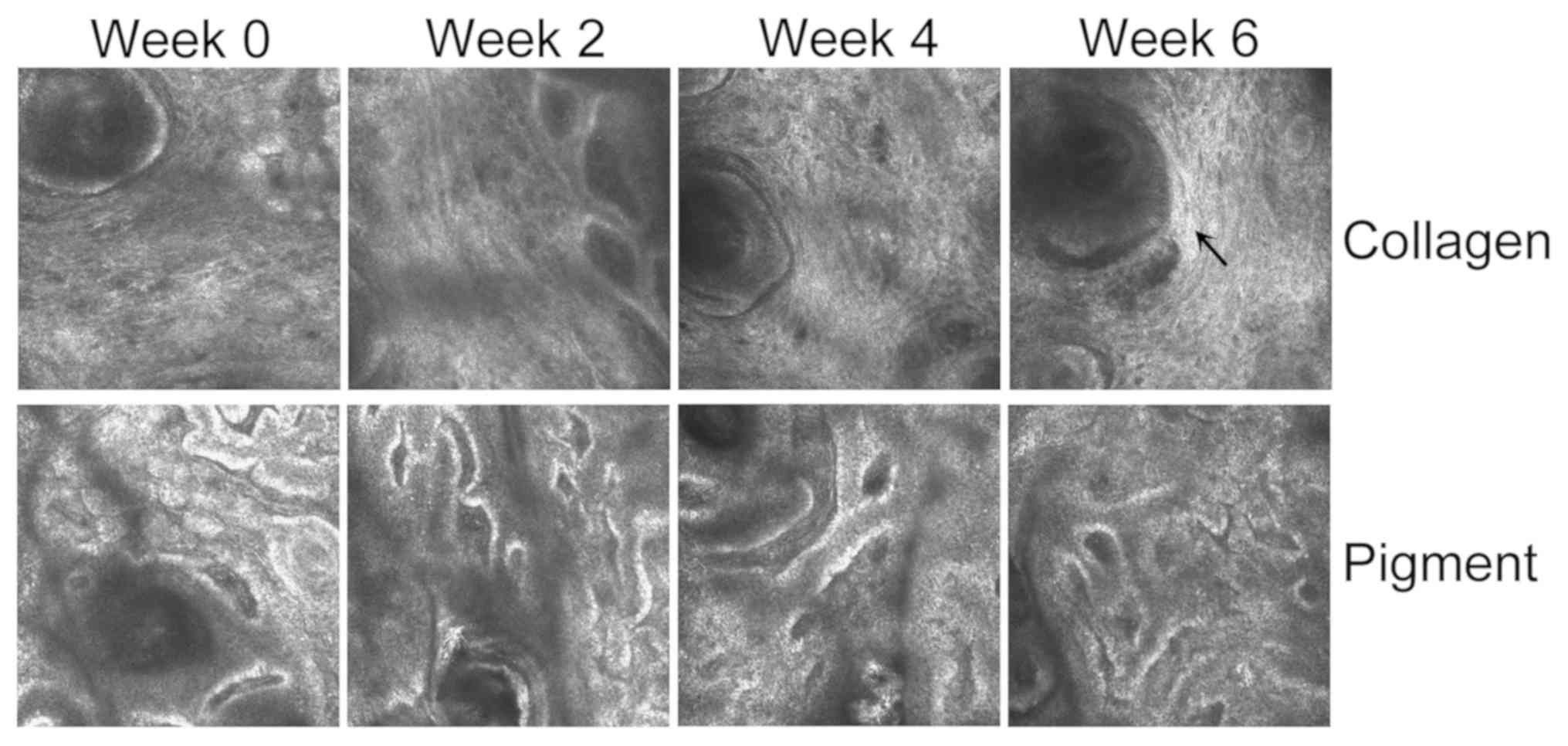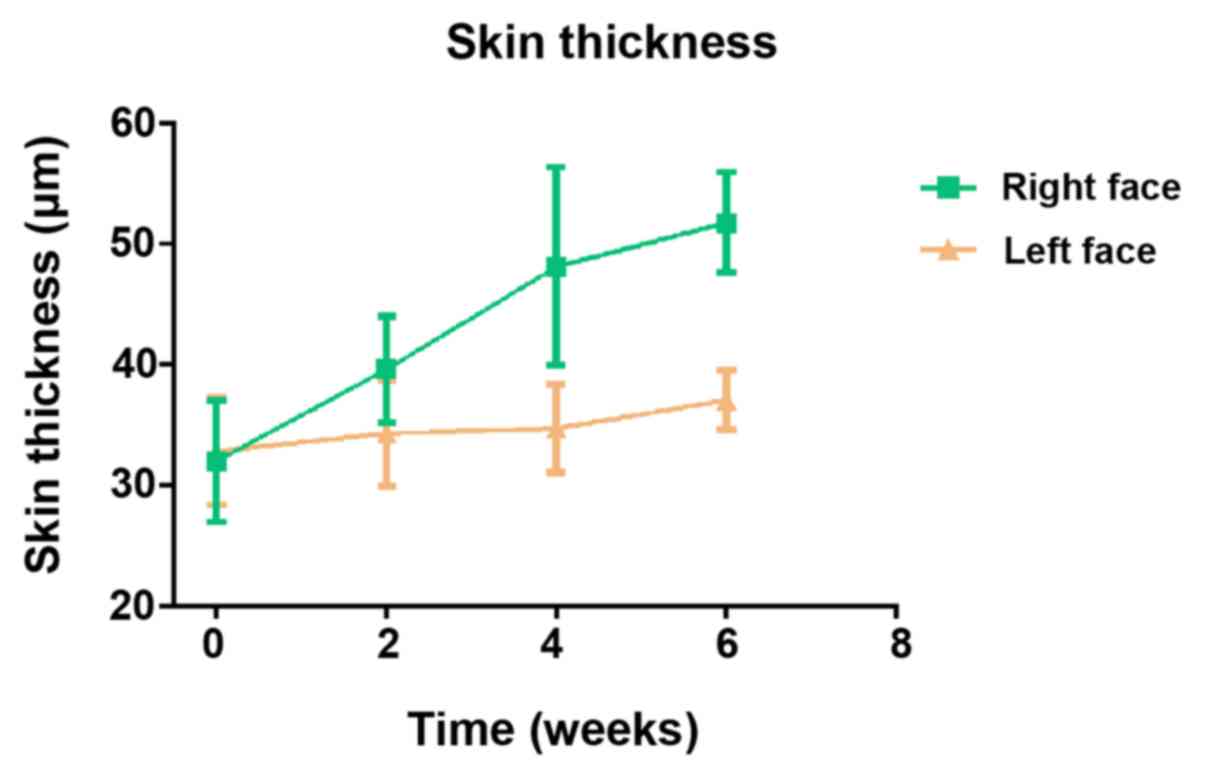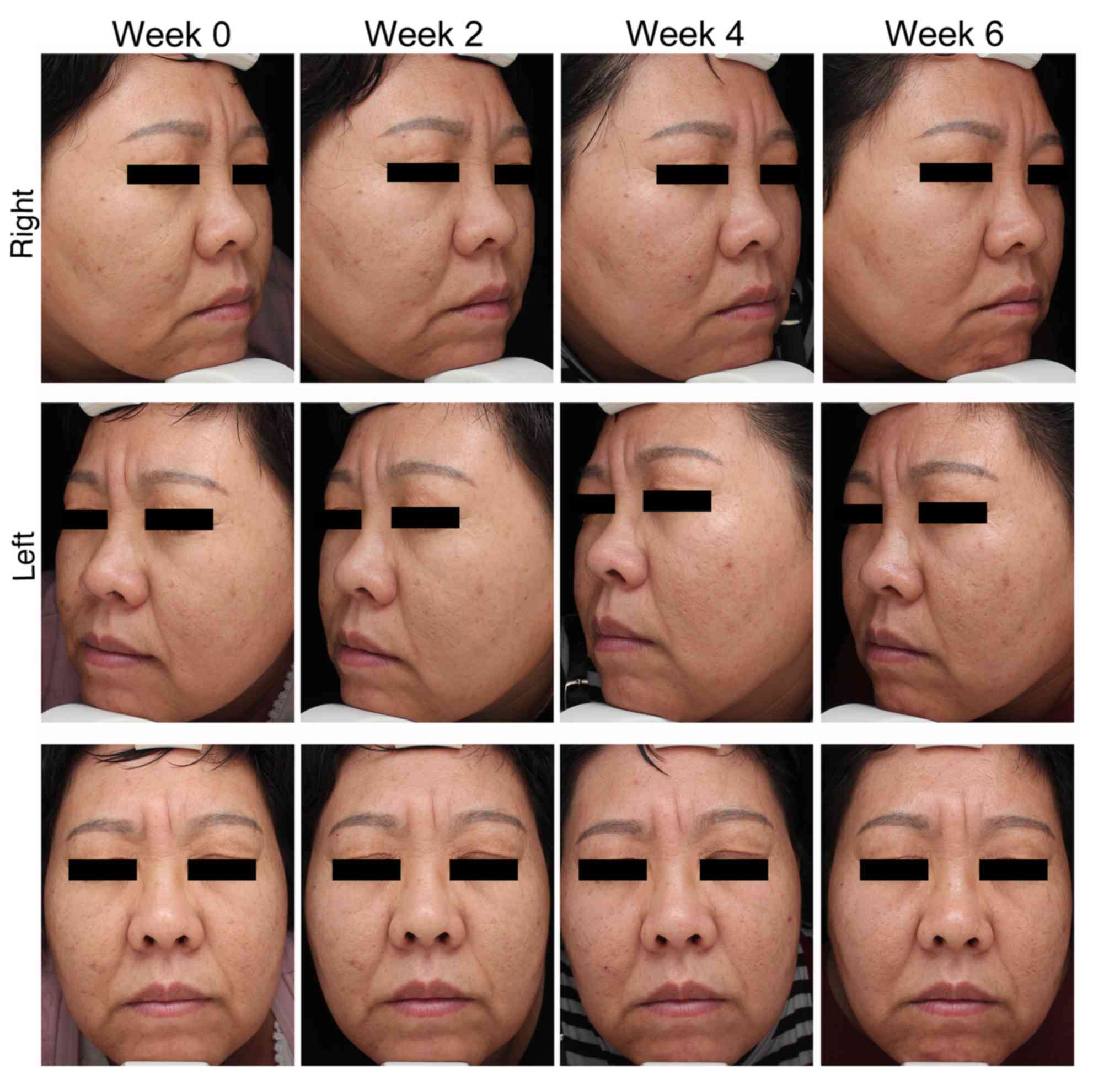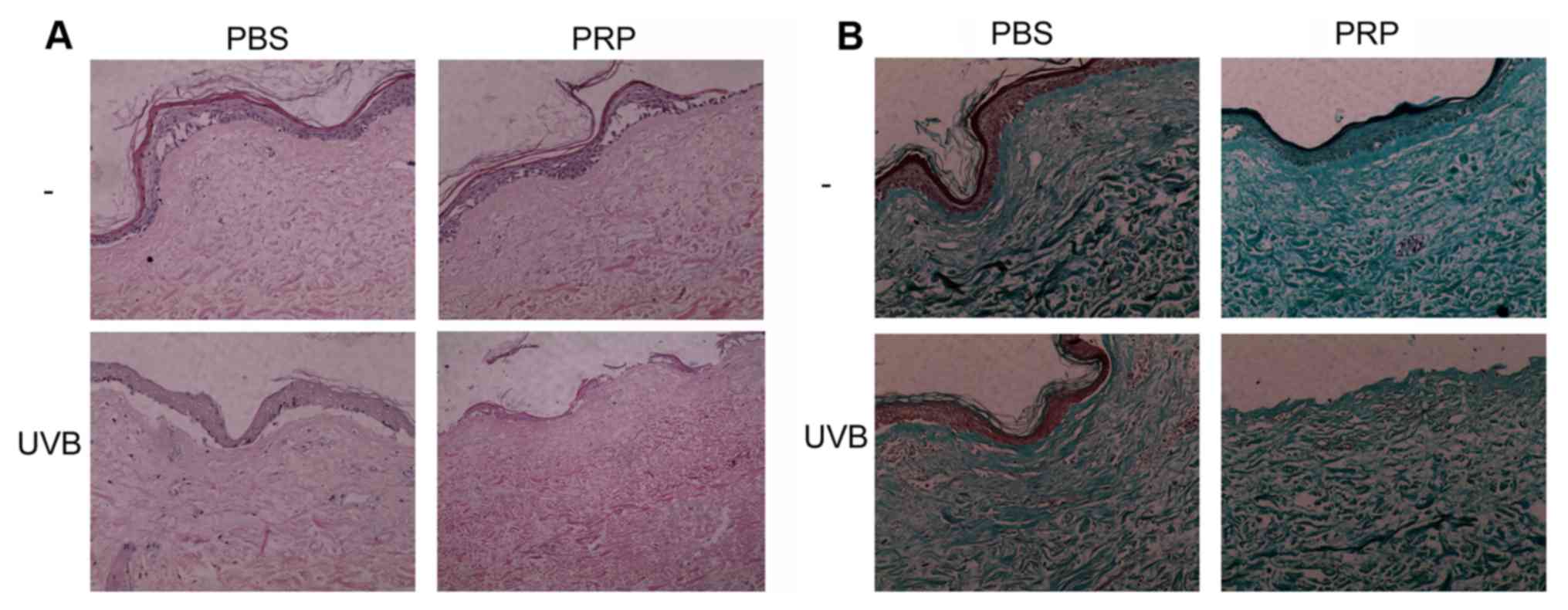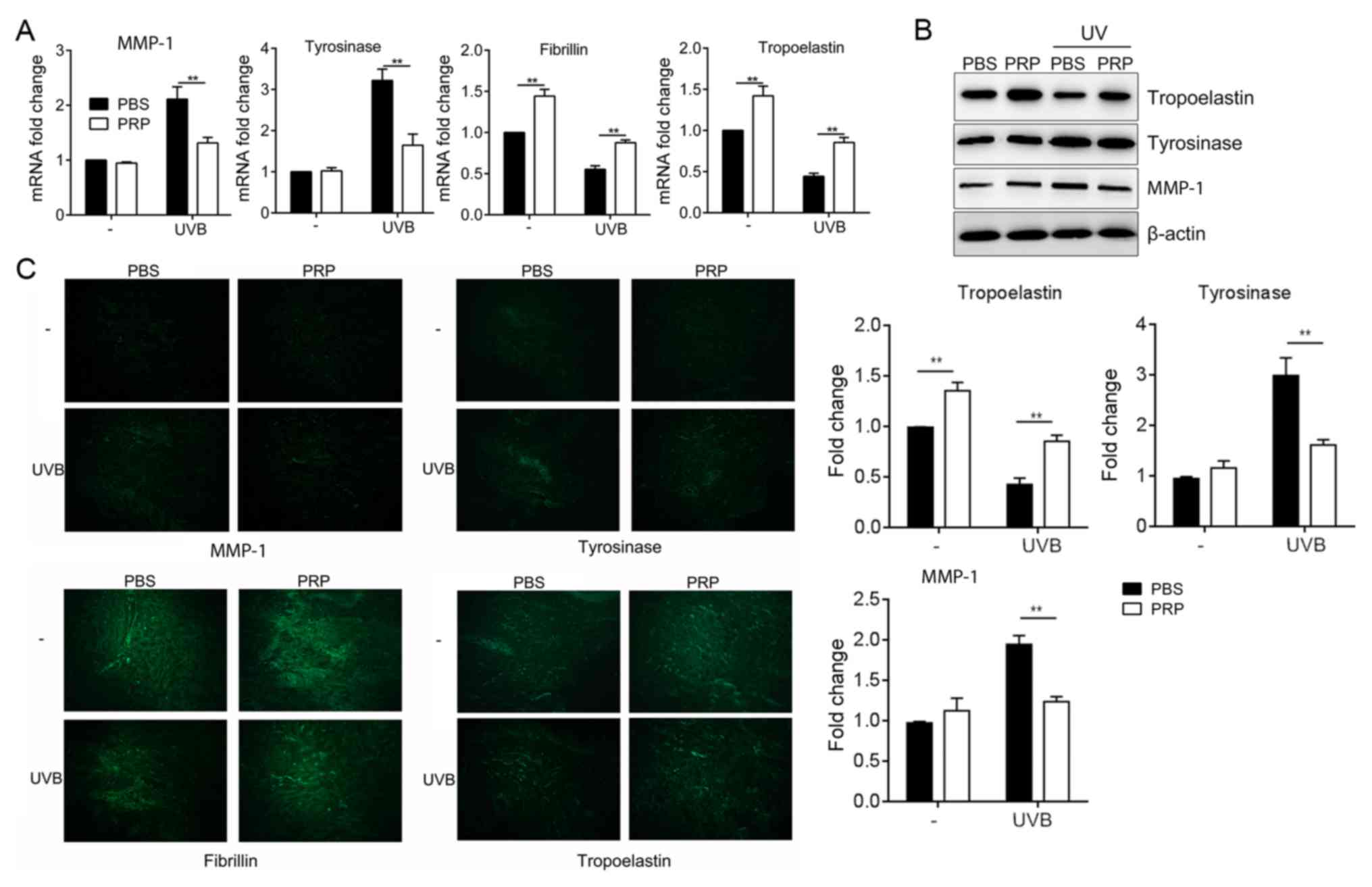|
1
|
Alexiades-Armenakas MR, Dover JS and Arndt
KA: The spectrum of laser skin resurfacing: Nonablative,
fractional, and ablative laser resurfacing. J Am Acad Dermatol.
58:719–737. 2008.PubMed/NCBI View Article : Google Scholar
|
|
2
|
Borrione P, Fagnani F, Di Gianfrancesco A,
Mancini A, Pigozzi F and Pitsiladis Y: The role of platelet-rich
plasma in muscle healing. Curr Sports Med Rep. 16:459–463.
2017.PubMed/NCBI View Article : Google Scholar
|
|
3
|
Ince B, Yildirim MEC, Dadaci M, Avunduk MC
and Savaci N: Comparison of the efficacy of homologous and
autologous platelet-rich plasma (PRP) for treating androgenic
alopecia. Aesthetic Plast Surg. 42(297)2018.PubMed/NCBI View Article : Google Scholar
|
|
4
|
Martinez-Zapata MJ, Martí-Carvajal AJ,
Solà I, Expósito JA, Bolíbar I, Rodríguez L, Garcia J and Zaror C:
Autologous platelet-rich plasma for treating chronic wounds.
Cochrane Database Syst Rev. CD006899:2016.PubMed/NCBI View Article : Google Scholar
|
|
5
|
Cervelli V, Nicoli F, Spallone D, Verardi
S, Sorge R, Nicoli M and Balzani A: Treatment of traumatic scars
using fat grafts mixed with platelet-rich plasma, and resurfacing
of skin with the 1540 nm nonablative laser. Clin Exp Dermatol.
37:55–61. 2012.PubMed/NCBI View Article : Google Scholar
|
|
6
|
Iozumi K, Hoganson GE, Pennella R, Everett
MA and Fuller BB: Role of tyrosinase as the determinant of
pigmentation in cultured human melanocytes. J Invest Dermatol.
100:806–811. 1993.PubMed/NCBI View Article : Google Scholar
|
|
7
|
Fisher GJ, Datta SC, Talwar HS, Wang ZQ,
Varani J, Kang S and Voorhees JJ: Molecular basis of sun-induced
premature skin ageing and retinoid antagonism. Nature. 379:335–339.
1996.PubMed/NCBI View
Article : Google Scholar
|
|
8
|
Pavlovic V, Ciric M, Jovanovic V and
Stojanovic P: Platelet Rich Plasma: A short overview of certain
bioactive components. Open Med (Wars). 11:242–247. 2016.PubMed/NCBI View Article : Google Scholar
|
|
9
|
Wang HL and Avila G: Platelet rich plasma:
Myth or reality? Eur J Dent. 1:192–194. 2007.PubMed/NCBI
|
|
10
|
Andia I, Sanchez M and Maffulli N: Joint
pathology and platelet-rich plasma therapies. Expert Opin Biol
Ther. 12:7–22. 2012.PubMed/NCBI View Article : Google Scholar
|
|
11
|
Foster TE, Puskas BL, Mandelbaum BR,
Gerhardt MB and Rodeo SA: Platelet-rich plasma: From basic science
to clinical applications. Am J Sports Med. 37:2259–2272.
2009.PubMed/NCBI View Article : Google Scholar
|
|
12
|
Frautschi RS, Hashem AM, Halasa B,
Cakmakoglu C and Zins JE: Current evidence for clinical efficacy of
platelet rich plasma in aesthetic surgery: A systematic review.
Aesthet Surg J. 37:353–362. 2017.PubMed/NCBI View Article : Google Scholar
|
|
13
|
Bielecki T, Dohan Ehrenfest DM, Everts PA
and Wiczkowski A: The role of leukocytes from L-PRP/L-PRF in wound
healing and immune defense: New perspectives. Curr Pharm
Biotechnol. 13:1153–1162. 2012.PubMed/NCBI View Article : Google Scholar
|
|
14
|
Borrione P, Gianfrancesco AD, Pereira MT
and Pigozzi F: Platelet-rich plasma in muscle healing. Am J Phys
Med Rehabil. 89:854–861. 2010.PubMed/NCBI View Article : Google Scholar
|
|
15
|
Yu W, Wang J and Yin J: Platelet-rich
plasma: A promising product for treatment of peripheral nerve
regeneration after nerve injury. Int J Neurosci. 121:176–180.
2011.PubMed/NCBI View Article : Google Scholar
|
|
16
|
El-Domyati M, Abdel-Wahab H and Hossam A:
Combining microneedling with other minimally invasive procedures
for facial rejuvenation: A split-face comparative study. Int J
Dermatol. 57:1324–1334. 2018.PubMed/NCBI View Article : Google Scholar
|
|
17
|
Charles-de-Sá L, Gontijo-de-Amorim NF,
Takiya CM, Borojevic R, Benati D, Bernardi P, Sbarbati A and
Rigotti G: Effect of use of platelet-rich plasma (PRP) in skin with
intrinsic aging process. Aesthet Surg J. 38:321–328.
2018.PubMed/NCBI View Article : Google Scholar
|
|
18
|
Kamakura T, Kataoka J, Maeda K, Teramachi
H, Mihara H, Miyata K, Ooi K, Sasaki N, Kobayashi M and Ito K:
Platelet-rich plasma with basic fibroblast growth factor for
treatment of wrinkles and depressed areas of the skin. Plast
Reconstr Surg. 136:931–939. 2015.PubMed/NCBI View Article : Google Scholar
|
|
19
|
Frade MA, Andrade TA, Aguiar AF, Guedes
FA, Leite MN, Passos WR, Coelho EB and Das PK: Prolonged viability
of human organotypic skin explant in culture method (hOSEC). An
Bras Dermatol. 90:347–350. 2015.PubMed/NCBI View Article : Google Scholar
|
|
20
|
Livak KJ and Schmittgen TD: Analysis of
relative gene expression data using real-time quantitative PCR and
the 2(-Delta Delta C(T)) method. Methods. 25:402–408.
2001.PubMed/NCBI View Article : Google Scholar
|
|
21
|
Marques LF, Stessuk T, Camargo IC, Sabeh
Junior N, dos Santos L and Ribeiro-Paes JT: Platelet-rich plasma
(PRP): Methodological aspects and clinical applications. Platelets.
26:101–113. 2015.PubMed/NCBI View Article : Google Scholar
|
|
22
|
Del Fabbro M, Panda S and Taschieri S:
Adjunctive use of plasma rich in growth factors for improving
alveolar socket healing: A systematic review. J Evid Based Dent
Pract. 19:166–176. 2019.PubMed/NCBI View Article : Google Scholar
|
|
23
|
Ali M, Mohamed A, Ahmed HE, Malviya A and
Atchia I: The use of ultrasound-guided platelet-rich plasma
injections in the treatment of hip osteoarthritis: A systematic
review of the literature. J Ultrason. 18:332–337. 2018.PubMed/NCBI View Article : Google Scholar
|
|
24
|
Qian Y, Han Q, Chen W, Song J, Zhao X,
Ouyang Y, Yuan W and Fan C: Platelet-rich plasma derived growth
factors contribute to stem cell differentiation in musculoskeletal
regeneration. Front Chem. 5(89)2017.PubMed/NCBI View Article : Google Scholar
|
|
25
|
Ramaswamy Reddy SH, Reddy R, Babu NC and
Ashok GN: Stem-cell therapy and platelet-rich plasma in
regenerative medicines: A review on pros and cons of the
technologies. J Oral Maxillofac Pathol. 22:367–374. 2018.PubMed/NCBI View Article : Google Scholar
|
|
26
|
Maisel-Campbell AL, Ismail A, Reynolds KA,
Poon E, Serrano L, Grushchak S, Farid C, West DP and Alam M: A
systematic review of the safety and effectiveness of platelet-rich
plasma (PRP) for skin aging. Arch Dermatol Res. Oct 18, 2019 2019
(Epub ahead of print). doi.org/10.1007/s0040. PubMed/NCBI View Article : Google Scholar
|
|
27
|
Cakin MC, Ozdemir B, Kaya-Dagistanli F,
Arkan H, Bahtiyar N, Anapali M, Akbas F and Onaran I: Evaluation of
the in vivo wound healing potential of the lipid fraction from
activated platelet-rich plasma. Platelets. 1–. 2019.PubMed/NCBI View Article : Google Scholar
|
|
28
|
Caruana A, Savina D, Macedo JP and Soares
SC: From platelet-rich plasma to advanced platelet-rich fibrin:
Biological achievements and clinical advances in modern surgery.
Eur J Dent. 13:280–286. 2019.PubMed/NCBI View Article : Google Scholar
|
|
29
|
Anitua E, Pino A, Jaen P and Orive G:
Plasma rich in growth factors enhances wound healing and protects
from photo-oxidative stress in dermal fibroblasts and 3D skin
models. Curr Pharm Biotechnol. 17:556–570. 2016.PubMed/NCBI View Article : Google Scholar
|
|
30
|
Aseichev AV, Azizova OA and Zhambalova BA:
Effect of UV-modified fibrinogen on platelet aggregation in
platelet-rich plasma. Bull Exp Biol Med. 133:41–43. 2002.PubMed/NCBI View Article : Google Scholar
|
|
31
|
Addor FAS: Beyond photoaging: additional
factors involved in the process of skin aging. Clin Cosmet Investig
Dermatol. 11:437–443. 2018.PubMed/NCBI View Article : Google Scholar
|
|
32
|
Aghajanova L, Houshdaran S, Balayan S,
Manvelyan E, Irwin JC, Huddleston HG and Giudice LC: In vitro
evidence that platelet-rich plasma stimulates cellular processes
involved in endometrial regeneration. J Assist Reprod Genet.
35:757–770. 2018.PubMed/NCBI View Article : Google Scholar
|
|
33
|
Yan S, Yang B, Shang C, Ma Z, Tang Z, Liu
G, Shen W and Zhang Y: Platelet-rich plasma promotes the migration
and invasion of synovial fibroblasts in patients with rheumatoid
arthritis. Mol Med Rep. 14:2269–2275. 2016.PubMed/NCBI View Article : Google Scholar
|
|
34
|
Shin MK, Lee JW, Kim YI, Kim YO, Seok H
and Kim NI: The effects of platelet-rich clot releasate on the
expression of MMP-1 and type I collagen in human adult dermal
fibroblasts: PRP is a stronger MMP-1 stimulator. Mol Biol Rep.
41:3–8. 2014.PubMed/NCBI View Article : Google Scholar
|















